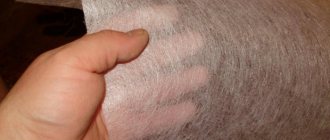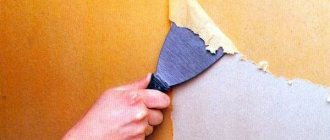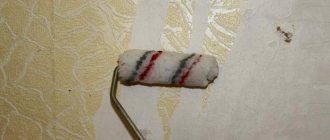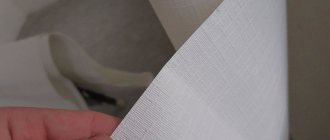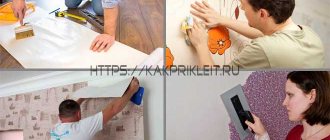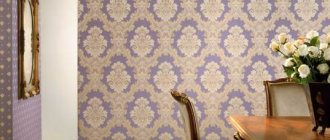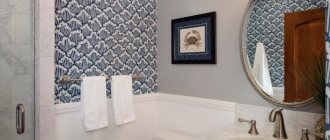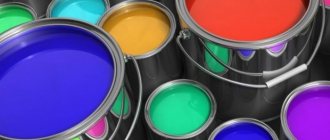Vinyl wallpaper on a non-woven basis is a cheaper option for wall decoration compared to a completely non-woven material, but they are practically not inferior to it in quality. This type of finish is resistant to damage, environmentally friendly and inexpensive, which is why it has become widespread. To hang vinyl wallpaper on non-woven backing (VF) correctly, it is enough to know the basic principles of operation and a few small secrets.
Attractive sides of vinyl canvases
Non-woven vinyl is a high-quality synthetic material. It is a two-layer coating:
- The base is a non-woven fabric consisting of cellulose fibers. Possessing high plasticity, it is in many ways superior to paper analogues. The material fits well on the surface, smoothes out and adheres to it. In this case, the glue is applied only to the wall.
- The front part of vinyl wallpaper is polyvinyl chloride. This layer can be structural (made of foamed vinyl), smooth, large-relief, hot-stamped, with silk threads interwoven.
Some of these wallpapers, specially designed for painting, can be painted many times, changing the interior of the room. They perfectly hide wall defects and mask planning flaws. Vinyl sheets are used in interiors decorated in different styles. This is a functional material with high performance characteristics: it will not have to be replaced for a long time.
Vinyl products are heavier in weight and larger in format. Rolls have different widths: from the traditional 53 cm to 70, 100 cm. The length varies and is 10, 15 and 20 meters. Wide canvases after gluing create the impression of a coating without seams. Such wallpapers are more expensive than paper-based materials, but attract consumers with their quality and excellent decorative effect.
Pros and cons of the vinyl plus non-woven combination
Formally, this wallpaper consists not of two, but of three layers - the non-woven base contains two layers - opaque, designed to hide the color unevenness of the walls, and decorative vinyl (types and nuances of gluing).
A huge variety of textures (including those imitating other materials) and patterns of such wallpapers allows you to implement quite bold design solutions.
One of the main advantages of using a non-woven base is considered to be ease of gluing. Although from a practical point of view, wallpaper has many other advantages:
- density and elasticity - allows the wallpaper to hide defects in the wall topography, even small cracks;
- tensile strength;
- resistance to abrasion and fading;
- durability;
- do not create problems during maintenance - both dry and wet cleaning are acceptable;
- high level of noise absorption;
- no deformation - wallpaper does not tend to stretch or shrink when exposed to moisture.
More often they are sold in meter lengths - in this article the nuances of gluing.
Does this finish have any disadvantages? The main negative point is associated with the likelihood of obtaining a vapor-tight wall surface that sometimes releases harmful substances.
Non-woven non-woven canvas, made from cellulose fibers with the participation of polymers, is not only soft and durable, it is also absolutely harmless to health. This, unfortunately, cannot be said about the vinyl layer applied on top of the base. Some wallpapers can be covered with a special breathable vinyl layer, but they are less accessible and expensive. As for regular vinyl, even products that have all the necessary certificates are not recommended for bedrooms and children's rooms. Find out: how to choose the right wallpaper.
DIY paper wallpapering
However, this only drawback of vinyl wallpaper can be practically eliminated by not forgetting to regularly ventilate the room.
Materials and tools for working with vinyl wallpaper
When purchasing vinyl wallpaper based on non-woven fabric as a wall covering, you need to take care of selecting a special glue. Regular paste or composition for paper webs is not suitable. You should not take universal dry mixtures: they may contain components harmful to this coating. The accompanying instructions for using vinyl wallpaper indicate the type of adhesive most suitable for attaching the sheets to the surface.
USEFUL INFORMATION: Is it possible to glue wallpaper on OSB and plywood: recommendations for preparing the base
To carry out preparatory work before wallpapering and the main process, you need to buy:
- putty or other material leveling the walls;
- primer composition;
- soft and hard (rubber) rollers;
- brush;
- sharp stationery knife, scissors;
- plumb line
If you don’t have the skill to work with vinyl products, you should start with canvases of regular size: 53 cm wide and 10 m long. Beginners are recommended to use a single-color coating without large patterns that require adjustment. Only after mastering the technique of handling such wallpaper can you try working with large-format products.
Features of wall covering: how long does vinyl wallpaper on non-woven backing take to dry?
Vinyl wallpaper looks just great, but to hang it, you need to take into account the rules and do all the work in a clear sequence.
The process of covering walls with stylish high-quality vinyl wallpaper consists of several stages, namely:
- Preparation of materials;
- Wall pasting;
- Corner processing;
- Processing of sockets and switches.
Before sticking wallpaper on the wall, you need to check each individual roll for consistency in shade and pattern, and then cut each canvas into separate strips. The stripes need to be cut so that the pattern matches and creates a coherent pattern throughout the room. Working with vinyl wallpaper is especially simple, because the glue must be applied exclusively to the wall and it is not at all necessary to saturate the canvas itself with glue. In order for the wallpaper to lie flat on the wall, you need to make markings using a level before carrying out the work.
Corners require special attention. The canvas must be glued in such a way that only 5 cm extends into the corner, and the subsequent strip must be glued overlapping. Then you need to trim the double joint with a sharp knife and you can join the edges
At the time of wallpapering, all switches and sockets must be completely de-energized. The boxes themselves need to be removed and a cross cut should be made in the place of the socket or switch, and then the corners should be bent inward. After the wallpaper is completely dry, you can install the switches and sockets in their original places.
When wallpapering, it is very important to know how long it takes vinyl wallpaper to dry. They dry quite quickly, the most important thing is to prevent the formation of drafts. The wallpaper will dry literally within a day.
Related article: Warm water floor: what is needed for the device, work procedure
Preparatory stage
Before gluing wallpaper on the walls, the surfaces must be prepared.
- Remove old covering: wallpaper, paint or other.
- Clean the base from glue and widen the cracks.
- Apply a layer of primer.
- Wall defects are eliminated using putty diluted to the optimal thickness.
- Liquid primer is applied again.
It is not at all necessary to thoroughly smooth the surface and make it absolutely flat. The selected wallpaper will cope with this task perfectly.
Preparatory work
Wall finishing requires preparatory work - this is an axiom and hardly anyone will argue with it. There are types of wallpaper that require careful leveling: plastering, putty, sanding. For the wallpaper we are considering, these requirements apply only when defects and problems are clearly visible on the walls: deep potholes, cracks, broken plaster, and so on. If, as mentioned earlier, they have minor unevenness and roughness, then preliminary preparation can only consist of removing the old coating and applying a primer.
The walls should be primed to provide greater adhesion and to save adhesive composition. It is advisable, if possible, to also unfasten the plinths - this will allow for proper gluing, and the plinth itself will remain unstained.
Cutting the canvases
To properly prepare the material itself, you need to do the following:
- Even at the stage of purchasing wallpaper, you need to check the batch numbers. Otherwise, the tubes may differ in color. If something was overlooked and one roll does not match the others in tone, it can be used for pasting hard-to-reach places, above window or door openings, in corners. Where the difference in color will not be noticeable.
- Using a centimeter tape, measure the height of the wall, add 5–7 cm to it for allowances at the bottom and top. This value is transferred to the wallpaper and cut to the required length. The next strips are compared with the first. If the products have an abstract design, they do not need to be customized. For large and small ornaments, a combination of lines will be required. It is better to do this on the floor, using 2 rolls at the same time.
USEFUL INFORMATION: How to properly glue wallpaper (video)
Advice. It will be easier to align the strips glued to the wall if you first apply markings to the surface: vertical lines, the distance between which is equal to the width of the roll.
Is it possible to paint vinyl wallpaper on non-woven backing?
Many people believe that vinyl wallpapers are harmful because they do not allow the walls to breathe and emit harmful substances. Vinyl wallpaper can be silk-screened or hot-stamped. Each of the types is divided into its own separate subtypes and has its own special pros and cons that must be taken into account when choosing such a finishing material.
Vinyl wallpaper is characterized by the fact that it can be painted and a special paint is used for this. Such wall coverings can imitate various materials, in particular tiles, fur, wood and much more.
If desired, you can draw beautiful patterns on the wallpaper, which are applied to the pre-painted surface of the wallpaper
Painting can be done:
- One tone;
- Special designs are applied using stencils;
- Vinyl wallpaper sticker used.
If there are certain doubts about choosing a shade or when applying a pattern, then it is best to start painting from an inconspicuous place. It is imperative to paint such a wall covering with paints that penetrate deep into the structure, because in this way it is quite possible to obtain a rich, deep shade. For painting, water-based or acrylic paints are used.
Article on the topic: Your garden in the English style: features of site design
Preparation and application of adhesive composition
The nuances of working with glue for non-woven fabrics:
- Vinyl wallpaper adhesive is sold dry. Before application, it is diluted with water in the ratio indicated on the packaging bag. Its consistency may be slightly thicker than manufacturers require.
- The main feature of non-woven wallpaper is that the adhesive mass is not applied to the canvas itself, as for other materials, but only to the wall. To ensure stability of the coating, you can additionally coat the edges of the strips.
- The composition applied to the wall dries quickly enough, so there is no need to cover a large area of the surface with it at once. In one step, you need to apply glue to a fragment of the wall slightly larger than the width of the wallpaper roll. The previously drawn marking lines will serve as reference points.
Which adhesive is best for non-woven vinyl wallpaper?
Many people are interested in what kind of glue is best for gluing vinyl wallpapers made on non-woven backing so that they stay on the walls for a long time and the aesthetic qualities of this material do not deteriorate. For gluing vinyl wallpaper, special adhesives are used or you can use universal wallpaper glue.
The main characteristics of this adhesive composition:
- High resistance to humidity;
- Increased sliding ability;
- Excellent adhesion to the wall.
When gluing vinyl wallpaper, you must choose the right adhesive composition and follow all the instructions.
Thanks to the peculiarities of the adhesive composition, it is possible to easily adjust the joints. In addition, this glue does not form lumps at all. Just a few minutes after dilution, the adhesive composition used for gluing vinyl wallpaper is completely ready for use, and the adhesive can be stored in a closed container for several weeks. Methylane glue, available in a wide range, is considered the most popular and popular. After reading user reviews, you can be convinced that this is an ideal adhesive for vinyl wallpaper.
Working with wallpaper
The process of gluing vinyl sheets onto non-woven fabric will look like this:
- They usually start pasting the walls from the window, continuing clockwise. You can read about other “starting point” options here.
- The sections prepared for gluing are rolled into a roll or in several rows so that they are easy to pick up and transfer to the surface.
- The upper edge of the strip is applied to the wall coated with glue, leaving an allowance for the ceiling of 1.5–2 cm.
- Using a plumb line they check how evenly the strip lies. If markings were applied to the wall, you will not have to do this.
- Use a rubber roller or a clean rag to roll over the canvas, trying to secure it first in the middle and then along the edges.
- Making smooth movements with little effort, the tool is passed along the entire section of wallpaper from top to bottom from the middle to the edges. For smooth canvases it is convenient to use a plastic spatula, for textured canvases - a roller.
USEFUL INFORMATION: Which wallpaper to choose for the kitchen?
- Carefully smooth the edges.
- The next strip is glued “end-to-end” to the previous one, trying to make sure that the canvases do not separate.
How to wash non-woven vinyl wallpaper and how to wash it correctly
When decorating walls, it is important to take into account the specific care of the wall covering used. If you wash the wallpaper incorrectly, you can harm it and remove the surface, thereby damaging the structure of the wall covering. However, it is necessary to take care of the wallpaper, because dirt and dust have a bad effect on the condition of the wallpaper and lead to its loss of attractiveness.
According to the conventions, vinyl wallpapers are divided into:
- Washable using soap;
- Washable using household chemicals;
- Resistant to high humidity.
When cleaning vinyl wallpaper, beware of abrasive cleaning products.
In addition, there are wallpapers that absolutely cannot be washed, but can only be wiped with a slightly damp cloth. If there is no dirt on the vinyl wallpaper, but only dust, then you should use a vacuum cleaner.
Important! When purchasing a wall covering, it is important to consider the characteristics of the material. For the kitchen, it is best to choose washable wallpaper that is resistant to high humidity.
Working in difficult places
Areas of the wall behind radiators, in corners, above window and door openings are considered difficult for gluing wallpaper.
- It will not be possible to use solid sheets behind radiators. A strip of a certain length is cut into 2-3 parts using a wave-like motion. Each piece is glued separately, trying to press it as tightly as possible against the wall. Here you should use a little more glue. The surface will heat up, so the thin layer of the composition will dry too quickly, and the wallpaper will come off.
- To cover the corners, it is recommended to glue two pieces together. The first canvas extends a few centimeters onto the next wall. The other edge is glued on top of it. Both canvases are cut through with a sharp knife, and excess thin strips are removed.
- The scraps left over from cutting the rolls are usually glued to the areas above the windows and doors.
Non-woven vinyl sheets are the best choice for beginners and the favorite material of professional finishers. After mastering the technology of applying this coating, the home craftsman will definitely have a desire to continue working with them further. The video below will help you get a visual idea of the process.
Installation of non-woven wallpaper
The standard procedure for gluing surfaces with vinyl wallpaper involves the arrangement of strips without overlapping - it is correct to glue such sheets end-to-end. This is done because the material is thick, the overlaps will be too noticeable. Thanks to this feature, you can start work from anywhere in the room.
This will avoid possible unevenness and joints of the canvas in a visible place.
At the zero point it is necessary to draw a vertical line along which the first strip will be aligned.
This can be done using a plumb line or a building level. The width of the outlined strip should be 1.5-2 cm less than the width of the roll. This edge must be turned at an angle.
The wall is carefully coated with glue. Another feature of the non-woven backing is that it does not need to be treated with glue - just apply it to the wall. It is important to avoid gaps; apply a thick layer of glue in the corners and under the ceiling with a small brush.
Important! When the repair time was during the summer heat, it is better to treat not only the wall, but also the wallpaper with glue.
While the strip is being measured and cut, the wall may dry out due to the high temperature.
A piece of the required length is cut from the roll (2-5 cm is added to the height of the walls). The upper edge of the canvas is aligned with the line under the ceiling and aligned relative to the vertical line. Using a rubber spatula or wallpaper roller, press the strip in the center, moving from top to bottom.
Now you need to expel excess glue and air. To do this, move the spatula from the center to the edges. Remove excess glue with a clean rag.
Tip! If the edges do not fit tightly to the wall, you can stick thin paper or a special paper tape for wallpaper under the seam. This way the fabric will stick more securely and the seams will be less noticeable.
The wallpaper near the ceiling is cut with a sharp knife.
First, they are pressed to the corner with a metal spatula, without removing it, and a straight line is drawn with a knife. If a plinth is installed below, the lower edges can be trimmed with scissors. All the same, the baseboard will cover the cutting line.
Press the wallpaper into a vertical corner with a plastic spatula, preventing the accumulation of glue and air bubbles there.
Cut the next strip from the roll. If the wallpaper has a pattern, it is more convenient to work with several rolls at once - this will reduce the material consumption.
The second strip must be glued, focusing along the edge of the previous one. The seam should be invisible, so the canvases are placed as close to each other as possible, but avoiding overlap. Non-woven wallpaper is very elastic; tightening it a couple of millimeters will not be difficult.
If the strip is crooked, you can tear it off the wall and stick it on again. However, you should not abuse this; with each tear, the glue will shift, forming clumps.
